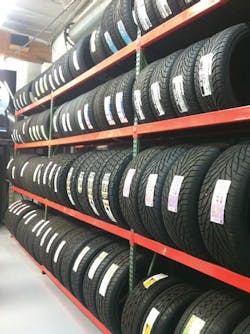Visual merchandising
Visual merchandising is an important element in the counter intelligence process. Visual merchandising is about presentation; it’s about selling products and creating a warm, friendly atmosphere for customers.
Visual merchandising is not a science; there are no hard and fast rules. The main idea is combining products and environment with the intention of increased sales.
I’m friends with a tire retailer in Simi Valley, Calif., who subscribed to the showroom-is-a-warehouse theory of merchandising.
When he opened his store decades ago, Simi Valley was a small cow town on the outskirts of a city. Agriculture was the primary industry.
But things changed; fields were turned into housing developments and shopping centers, schools popped up, and it grew from an agricultural hub to a vibrant city suburb.
Several years ago I visited this friend, and we spent an afternoon visiting other tire dealers and a few specialty retailers in his immediate area. We then returned to his store, and as we walked just inside the entrance, I asked him to turn around, face the parking lot and describe his showroom.
He didn’t say much. I stood next to him and said, “I see tires that are not in proper order, with labels not facing outward. There are old, uncomfortable chairs, and not enough chairs for all of your customers. I see old magazines hanging off the edge of a small table, and old, sun-bleached tire banners that are drooping in the center with layers of dust. I see cases of half-opened, tube florescent bulbs stacked on top of vending machines.”
With that, he turned around and said, “I don’t know how long those light tubes have been on the vending machines.” He made a decision to do something about it right then and there.
First, all tires were removed, and new ceiling tiles were installed, bright paint was applied to the walls, and tire-stained floor tiles were replaced. He then bought two oversized leather couches, along with several new tables. He also installed a large-screen TV in the waiting area, along with several high-top tables with stools.
His customers, especially the long-time, loyal customers, could not stop talking about the upgrades. He ordered a variety of tire displays from vendors and manufacturers, and tires were properly merchandised off the floor. Custom wheels were polished and displayed, and the showroom was completely transformed. Lastly, he hired a young, local artist to hand-paint images on the walls that tied in with early, bygone-era photos of his town.
[PAGEBREAK]
Take a fresh look
This dealer was blinded by routine; it’s easily done.
Take a fresh look at your store, inside and out. Ask your customers what you could do to make your store more comfortable and inviting. Ask a few women customers; they make up a large percentage of your customer base, and they will appreciate that you asked.
The New Oxford Dictionary of English defines visual merchandising as the activity of promoting the sale of goods, especially by their presentation in retail outlets. There are many retailers today, such as Target stores, which do a fantastic job of product presentation. Wal-Mart is currently spending hundreds of millions on improving its visual merchandising.
The visual merchandising inside a Starbucks is amazing. As a marketing guy, I can’t help but notice every shelf has been planned and well-executed.
Though the Internet is a valuable resource for consumers to research tires and auto service, the retail outlet is still, by a huge margin, the crossroads of all channels.
In my past experience as a regional director for a large regional retailer, I worked hard with my store managers and counter staff to merchandise for margin.
I remember one store manager made this comment in a monthly sales meeting, “I wish my tire margin would go up.” My reply was, “I wish it would go up, too.” Then I asked all the managers in the room what amount of increase they thought we could achieve by wishing our gross profit margin would improve.
Zero was the correct answer. Wishing doesn’t get the job done. Upon visiting that particular store, it was easy to see why their margin was so low. They only displayed cheap, low-priced tires.
After several hours of re-displaying and re-merchandising the salesroom floor, it was visually merchandised and merchandised for margin!
I wish all problems were that easy to fix!
Wayne Williams is president of ExSell Marketing Inc., a “counter intelligence” firm based in La Habra, Calif. He can be reached at [email protected].
